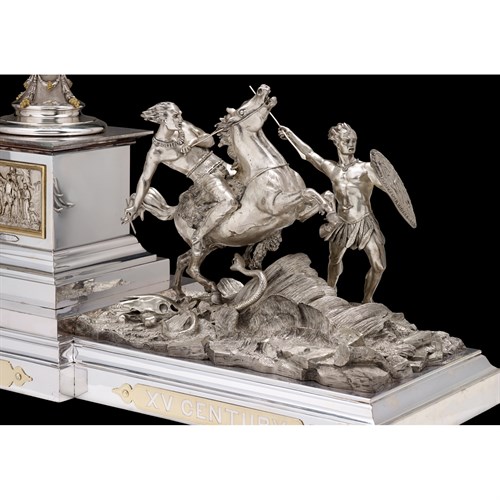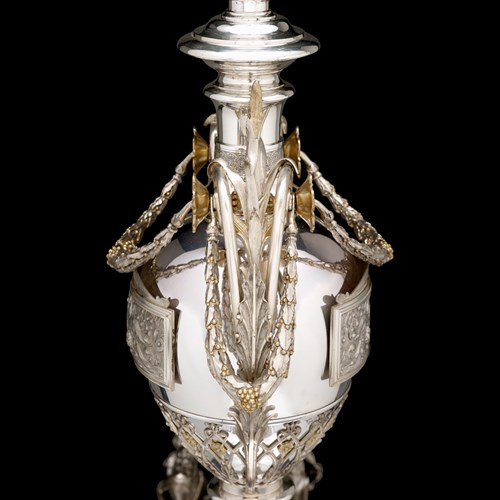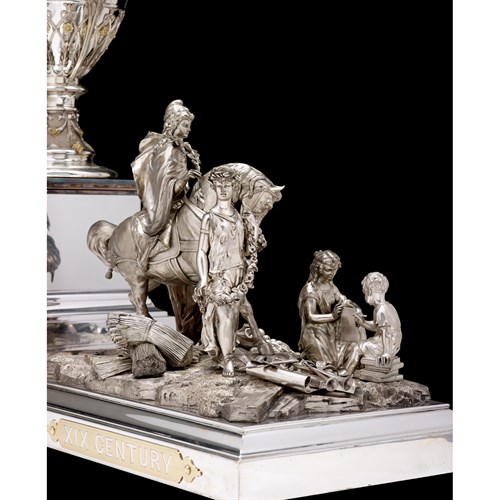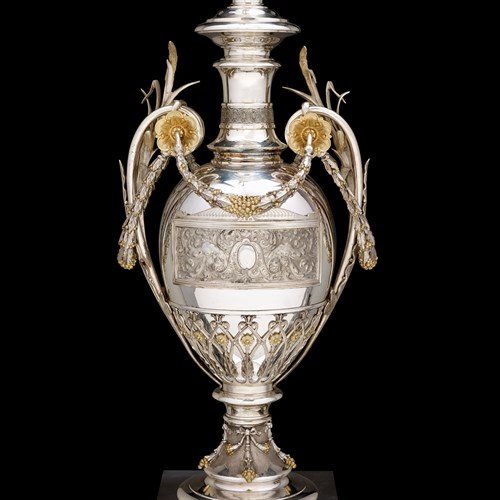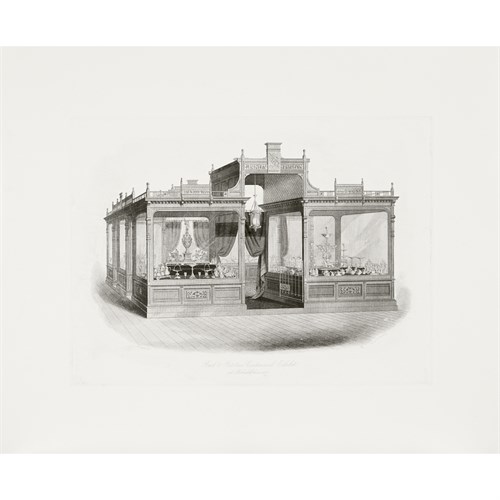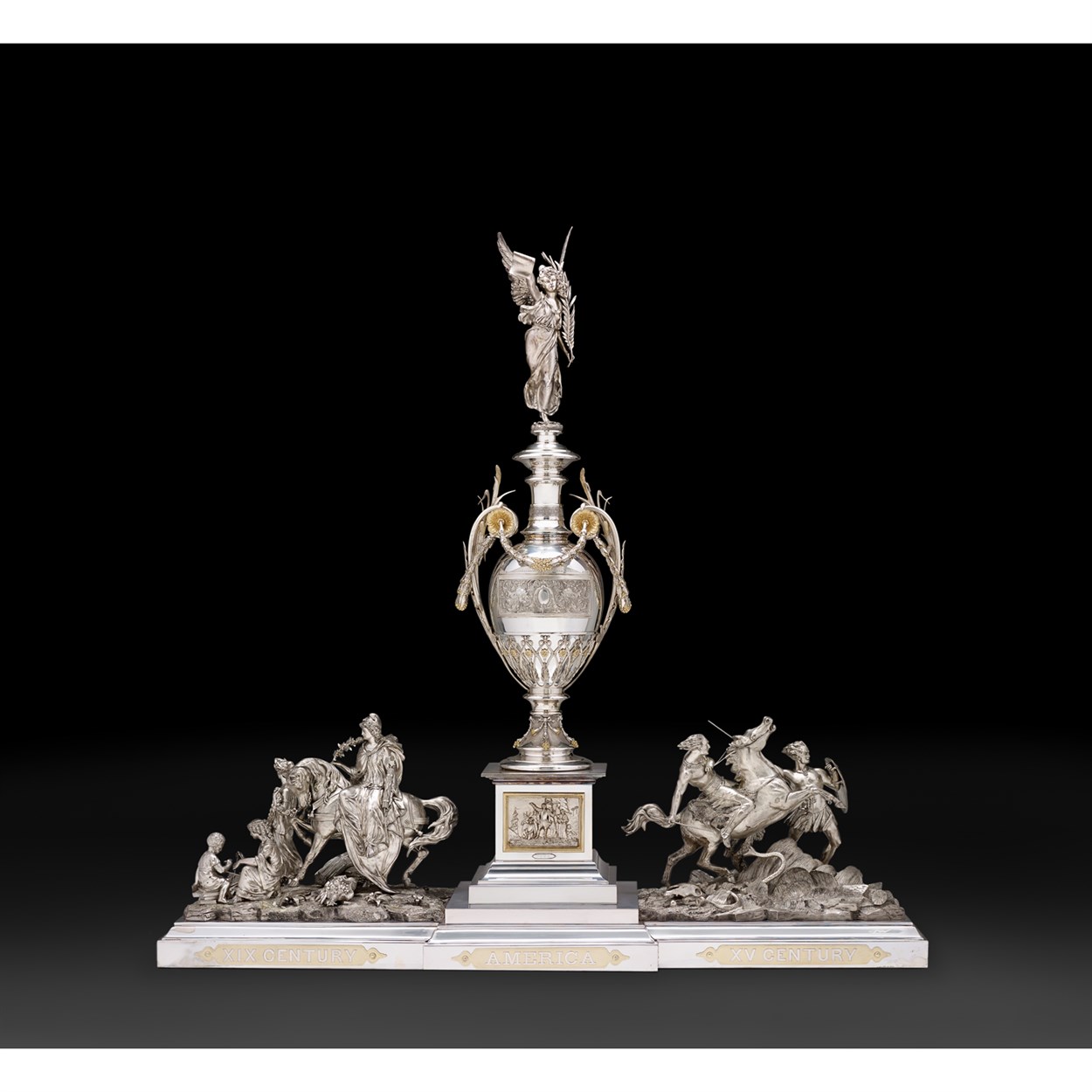November 11, 2015 10:00 EST
American Furniture, Folk & Decorative Arts
266
The Progress Vase: A Magnificent Sterling Silver and Silver-plated Centerpiece
designed by w.c. beattie for reed & barton, taunton, ma, circa 1875
The large central twin-handled urn with maize stalks emerging between the handles and four laurel swags suspended around the shoulder, surmounted by a figure of Liberty standing on a broken chain and holding the palm of victory and a scroll inscribed, "Progress," raised on a square pedestal bearing a relief plaque depicting the landing of Columbus and the date 1492, flanked to each side by a large figural group, one side representative of America in the 15th century, depicting two Native warriors, one mounted and in full gallop, the other standing with shield and spear held aloft, above a rocky base with a serpent striking below the horse and a horse skull, above a plaque reading "XV Century;" the other group, representative of America in the 19th century, depicting Columbia in flowing robes on a horse led by Plenty holding a floral bridle, the rocky base bears a cornucopia, two sheaves of wheat, and a collection of various tools and instruments allegorical of the Arts and Sciences, and a figure of a maiden instructing a seated boy how to write, above a plaque reading "XIX Century," all raised on cavetto molded base centered by a plaque reading "America."
H: 49 in. W: 49 3/4 in. D: 15 in. (overall)
Provenance: Property from the Reed & Barton Archives, Taunton, Massachusetts.
Exhibited: Smithsonian Institute, Washington D.C., 1976.
Chicago World's Fair, 1933-34.
Philadelphia International Centennial Exhibition, 1876.
Sold for $125,000
Estimated at $150,000 - $250,000
The large central twin-handled urn with maize stalks emerging between the handles and four laurel swags suspended around the shoulder, surmounted by a figure of Liberty standing on a broken chain and holding the palm of victory and a scroll inscribed, "Progress," raised on a square pedestal bearing a relief plaque depicting the landing of Columbus and the date 1492, flanked to each side by a large figural group, one side representative of America in the 15th century, depicting two Native warriors, one mounted and in full gallop, the other standing with shield and spear held aloft, above a rocky base with a serpent striking below the horse and a horse skull, above a plaque reading "XV Century;" the other group, representative of America in the 19th century, depicting Columbia in flowing robes on a horse led by Plenty holding a floral bridle, the rocky base bears a cornucopia, two sheaves of wheat, and a collection of various tools and instruments allegorical of the Arts and Sciences, and a figure of a maiden instructing a seated boy how to write, above a plaque reading "XIX Century," all raised on cavetto molded base centered by a plaque reading "America."
Provenance: Property from the Reed & Barton Archives, Taunton, Massachusetts.
Exhibited: Smithsonian Institute, Washington D.C., 1976.
Chicago World's Fair, 1933-34.
Philadelphia International Centennial Exhibition, 1876.
The award-winning centerpiece of Reed & Barton's display in the Main Exhibition Hall at the 1876 Philadelphia International Centennial Exhibition. Described by Reed & Barton in their notes for the Exhibition judges as "A Symbolic Representation of the Progress of America, from Savage to Civilized Life, embracing the period in History from its Discovery to the Present Time," and by the awards judges as "an original and elaborate composition of striking character and praiseworthy excellence, both in design and execution," the Progress Vase foretells the rise of America in terms of industry, commerce, art, and science on the hundredth anniversary of the nation's independence. The contrast between the depictions of the Native Americans, with their chaotic and warlike poses, running over a barren and untamed land littered with skulls and serpents; and the 19th century Americans, represented as goddesses and serene figures derived from Antiquity--beautiful, calm and surrounded by bounty, perfectly encapsulates 19th century attitudes towards progress, manifest destiny and the building of the American nation.
The 1876 Philadelphia International Centennial Exhibition was not Reed & Barton's first such fair, they having exhibited both at the Exposition Internacional de Chili held in Santiago in 1875, and the New York World's Fair in 1854, where, the company states, they "received the first Premiums, Medals and Diplomas." For their Philadelphia exhibit, the company showed 1040 articles the combined value of which was $24,500, and the cost to exhibit them a hefty $15,250. Correspondence the company had with Henry Pettit, Chief of the Bureau of Installation for the Centennial, reveals that Reed & Barton requested a "rosewood & French plate glass case & base for same to contain a display of gold and silver plated ware" and that it "should be placed where there is good light... and a wide passage completely round it" to occupy the not inconsiderable space of 216 (amended from 209) square feet. The reply from Pettit on October 25th 1875 revealed that "the drawing of the case has not yet arrived, and we will wait until we see it before granting such a large space. Please hurry it up." They sent the drawing two days later, and were eventually installed in the East Transept of Main Building, no. 47.
Given the Exhibition's theme of celebrating America's Independence, many American silver manufacturing companies produced large scale centerpieces for the Exhibition that highlighted the strength and accession of America, and demonstrated that American firms' design and execution in the fine arts was as good, if not better, than that being produced in Europe at that time. Reed & Barton's Progress Vase, and Gorham's sterling silver Century Vase (which won the Exhibition's comparable award for solid sterling silver), are the two most notable of these. As well as the award for the Progress Vase, Reed & Barton also won an award for their coffin mounts (praised for their "fine workmanship and ornamental finish"), and one for their overall display, including "...dinner and tea services, and all varieties of household and table ware... with finish of a superior character... their designs of great excellence." Reed & Barton later exhibited at several other fairs, the following being the American Institute Fair in New York in 1878, where they also won awards for their fine quality of workmanship and design.



